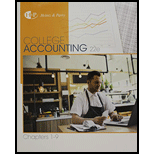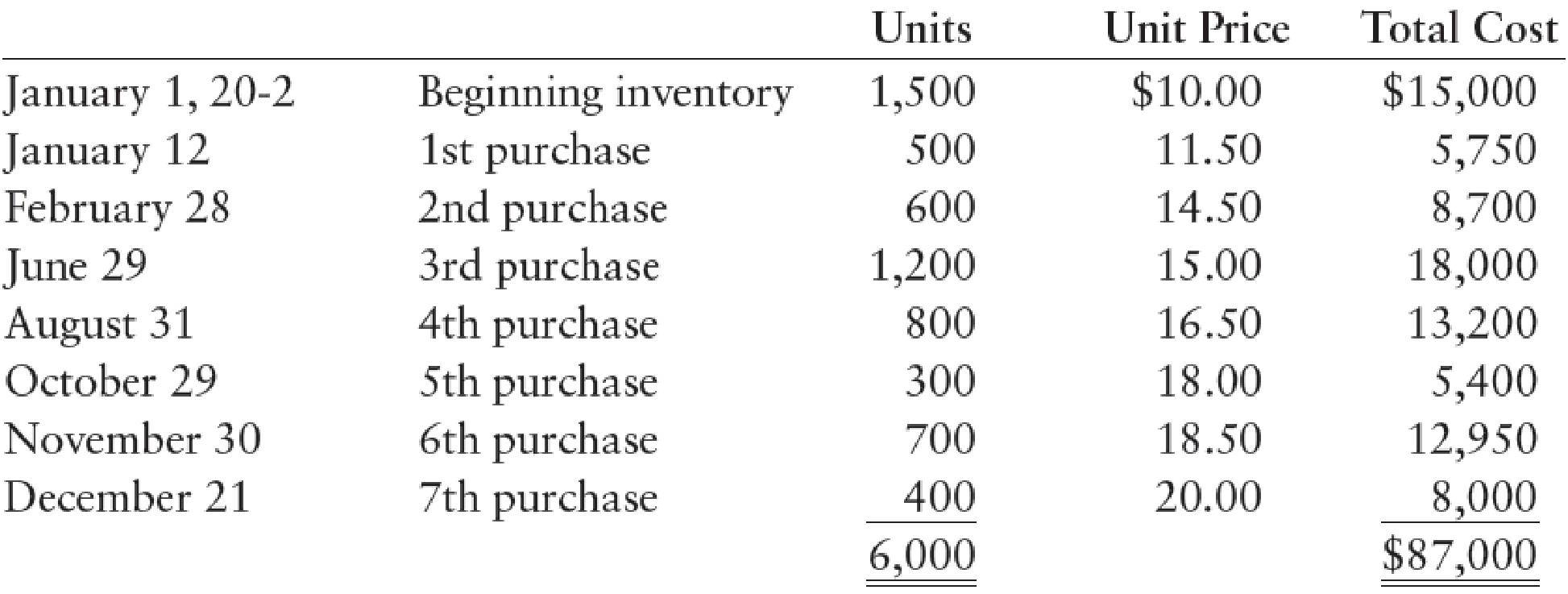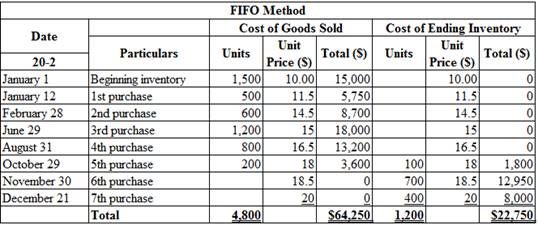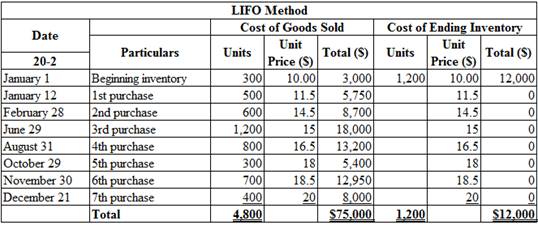
Concept explainers
Hurst Company’s beginning inventory and purchases during the fiscal year ended December 31, 20-2, were as follows:

There are 1,200 units of inventory on hand on December 31, 20-2.
REQUIRED
- 1. Calculate the total amount to be assigned to the cost of goods sold for 20-2 and ending inventory on December 31 under each of the following periodic inventory methods:
- (a) FIFO
- (b) LIFO
- (c) Weighted-average (round calculations to two decimal places)
- 2. Assume that the market price per unit (cost to replace) of Hurst’s inventory on December 31 was $18. Calculate the total amount to be assigned to the ending inventory on December 31 under each of the following methods:
- (a) FIFO lower-of-cost-or-market
- (b) Weighted-average lower-of-cost-or-market
- 3. In addition to taking a physical inventory on December 31, Hurst decides to estimate the ending inventory and cost of goods sold. During the fiscal year ended December 31, 20-2, net sales of $100,000 were made at a normal gross profit rate of 35%. Use the gross profit method to estimate the cost of goods sold for the fiscal year ended December 31 and the inventory on December 31.
1.
(a)
Calculate the total amount of cost of goods sold and cost of ending inventory on December 31, under FIFO method (Periodic inventory system).
Explanation of Solution
First-in-First-Out (FIFO): In First-in-First-Out method, the first purchased items are sold first. The value of the ending inventory consists of the recently purchased items.
Calculate the total amount of cost of goods sold and cost of ending inventory on December 31, under FIFO method (Periodic inventory system):

Table (1)
Therefore, the cost of sold and cost of ending inventory under FIFO (Periodic inventory system) is $64,250 and $22,750.
2.
(b)
Calculate the total amount of cost of goods sold and cost of ending inventory on December 31, under LIFO method (Periodic inventory system).
Explanation of Solution
Last-in-First-Out (LIFO): In Last-in-First-Out method, the last purchased items are sold first. The value of the closing stock consists of the initially purchased items.
Calculate the total amount of cost of goods sold and cost of ending inventory on December 31, under LIFO method (Periodic inventory system):

Table (2)
Therefore, the cost of sold and cost of ending inventory under LIFO (Periodic inventory system) is $75,000 and $12,000.
3.
(c)
Calculate the total amount of cost of goods sold and cost of ending inventory on December 31, 20-2 under weighted average cost method.
Explanation of Solution
Weighted-average cost method: Under average cost method inventories are priced at the average of all available inventories. Average cost is the quotient of total cost of goods available for sale and total units available for sale.
Calculate the total amount of cost of goods sold and cost of ending inventory on December 31 under weighted average cost method:
Step 1: Calculate the weighted-average cost.
Step 2: Calculate the amount of ending inventory.
Step 3: Calculate the amount of cost of goods sold.
Therefore, the cost of sold and cost of ending inventory under weighted average cost method (Periodic inventory system) is $69,600 and $17,400.
2.
(a)
Calculate the cost of ending inventory on December 31 under FIFO method (Lower of cost or market).
Explanation of Solution
Lower-of-cost-or-market: The lower-of-cost-or-market (LCM) is a method which requires the reporting of the ending merchandise inventory in the financial statement of a company, at its current market value or at is historical cost price, whichever is less.
First-in-First-Out (FIFO): In First-in-First-Out method, the first purchased items are sold first. The value of the ending inventory consists of the recently purchased items.
Calculate the cost of ending inventory under FIFO (Lower of cost or market):
|
Particulars |
FIFO Cost (A) |
Market Cost (B) |
LCM Valuation (C = A or B ) Whichever is lesser |
| Ending inventory under FIFO | $22,750 | $21,600 | $21,600 |
Table (3)
Working note:
Calculate the market cost.
Therefore, the cost of ending inventory on December 31 under FIFO method (Lower of cost or market) is $21,600.
2.
(b)
Calculate the cost of ending inventory on December 31 under weighted average cost method (Lower of cost or market).
Explanation of Solution
Weighted-average cost method: Under average cost method inventories are priced at the average of all available inventories. Average cost is the quotient of total cost of goods available for sale and total units available for sale.
Calculate the cost of ending inventory under weighted average cost (Lower of cost or market):
|
Particulars |
Weighted Average Cost (A) |
Market Cost (B) |
LCM Valuation (C = A or B ) Whichever is lesser |
| Ending inventory under weighted average cost | $17,400 | $21,600 | $17,400 |
Table (4)
Working note:
Calculate the market cost.
Therefore, the cost of ending inventory on December 31 under weighted average cost method (Lower of cost or market) is $17,400.
3.
Estimate the cost of goods sold and ending inventory for the year December 31 uing the gross profit methods.
Explanation of Solution
Gross profit method:
- Gross profit method is used to determine the amount of estimated inventory lost or destroyed by theft, fire, or other hazards.
- The gross profit for the period is calculated from the preceding year, which is adjusted for any current period changes in the sales and cost price of the inventory.
- It estimates the value of inventory and cost of goods sold by avoiding the expenses occurred on physical count of inventory.
Estimate the cost of goods sold and ending inventory for the year December 31 uing the gross profit methods:
| Gross profit Method | ||
| Details | Amount ($) | Amount ($) |
| Beginning inventory, January 1, 20-2 | 15,000 | |
| Add: Net cost of purchases, January 1, 20-2 – December 31, 20-2 | 72,000 | |
| Cost of goods available for sale | 87,000 | |
| Less: Estimated cost of goods sold. | ||
| Net sales | 100,000 | |
| Less: Estimated gross profit of 35% | (35,000) | |
| Estimated cost of goods sold | (65,000) | |
| Estimated cost of inventory at December 31, 20-2 | $22,000 | |
Table (5)
Working note:
Calculate the estimated gross profit.
The estimated gross profit is 35% of the net sales.
Therefore, the estimated cost of goods sold and ending inventory for the year December 31 uing the gross profit methods is $65,000 and $22,000.
Want to see more full solutions like this?
Chapter 13 Solutions
Bundle: College Accounting, Chapters 1-9, Loose-leaf Version, 22nd + Cengagenowv2, 1 Term Printed Access Card
- COST ALLOCATION AND LOWER-OF-COST-OR-MARKET Hall Companys beginning inventory and purchases during the fiscal year ended December 31, 20--, were as follows: There are 1,100 units of inventory on hand on December 31. REQUIRED 1. Calculate the total amount to be assigned to the ending inventory and cost of goods sold on December 31 under each of the following methods: (a) FIFO (b) LIFO (c) Weighted-average (round calculations to two decimal places) 2. Assume that the market price per unit (cost to replace) of Halls inventory on December 31 was 16. Calculate the total amount to be assigned to the ending inventory on December 31 under each of the following methods: (a) FIFO lower-of-cost-or-market (b) Weighted-average lower-of-cost-or-market 3. Prepare required entries to apply: (a) FIFO lower-of-cost-or-market (b) Weighted-average lower-of-cost-or-marketarrow_forwardData on the physical inventory of Ashwood Products Company as of December 31 follow: Quantity and cost data from the last purchases invoice of the year and the next-to-the-last purchases invoice are summarized as follows: Instructions Determine the inventory at cost as well as at the lower of cost or market, using the first-in, first-out method. Record the appropriate unit costs on the inventory sheet and complete the pricing of the inventory. When there are two different unit costs applicable to an item, proceed as follows: 1. Draw a line through the quantity and insert the quantity and unit cost of the last purchase. 2. On the following line, insert the quantity and unit cost of the next-to-the-last purchase. 3. Total the cost and market columns and insert the lower of the two totals in the Lower of C or M column. The first item on the inventory sheet has been completed as an example.arrow_forwardBeginning inventory, purchases, and sales for WCS12 are as follows: Assuming a perpetual inventory system and using the weighted average method, determine (a) the weighted average unit cost after the October 22 purchase, (b) the cost of goods sold on October 29, and (c) the inventory on October 31.arrow_forward
- Data on the physical inventory of Katus Products Co. as of December 31 follow: Quantity and cost data from the last purchases invoice of the year and the next-to-the-last purchases invoice are summarized as follows: Instructions Determine the inventory at cost as well as at the lower of cost or market, using the first-in, first-out method. Record the appropriate unit costs on the inventory sheet and complete the pricing of the inventory. When there are two different unit costs applicable to an item: 1. Draw a line through the quantity and insert the quantity and unit cost of the last purchase. 2. On the following line, insert the quantity and unit cost of the next-to-the-last purchase. 3. Total the cost and market columns and insert the lower of the two totals in the LCM column. The first item on the inventory sheet has been completed as an example.arrow_forwardThe beginning inventory for Dunne Co. and data on purchases and sales for a three-month period are shown in Problem 7-1B. Instructions 1. Determine the inventory on June 30 and the cost of merchandise sold for the three-month period, using the first-in, first-out method and the periodic inventory system. 2. Determine the inventory on June 30 and the cost of merchandise sold for the three-month period, using the last-in, first-out method and the periodic inventory system. 3. Determine the inventory on June 30 and the cost of merchandise sold for the three-month period, using the weighted average cost method and the periodic inventory system. Round the weighted average unit cost to the dollar. 4. Compare the gross profit and June 30 inventories using the following column headings:arrow_forwardPappas Appliances uses the periodic inventory system. Details regarding the inventory of appliances at January 1, purchases invoices during the year, and the inventory count at December 31 are summarized as follows: Instructions 1. Determine the cost of the inventory on December 31 by the first-in, first-out method. Present data in columnar form, using the following headings: If the inventory of a particular model comprises one entire purchase plus a portion of another purchase acquired at a different unit cost, use a separate line for each purchase. 2. Determine the cost of the inventory on December 31 by the last-in, first-out method, following the procedures indicated in (1). 3. Determine the cost of the inventory on December 31 by the weighted average cost method, using the columnar headings indicated in (1). 4. Discuss which method (FIFO or LIFO) would be preferred for income tax purposes in periods of (a) rising prices and (b) declining prices.arrow_forward
- Reid Company uses the periodic inventory system. On January 1, it had an inventory balance of 250,000. During the year, it made 613,000 of net purchases. At the end of the year, a physical inventory showed it had ending inventory of 140,000. Calculate Reid Companys cost of goods sold for the year.arrow_forwardOn January 1 of Year 1, Dorso Company adopted the dollar-value LIFO method of inventory costing. Dorsos December 31 ending inventory records are as follows: Year 1: Current cost, 20,000; Index, 100 Year 2: Current cost, 33,600; Index, 120 Using the dollar-value LIFO method, compute Dorsos December 31 ending inventory for Year 2.arrow_forwardCalculate the cost of goods sold dollar value for A67 Company for the month, considering the following transactions under three different cost allocation methods and using perpetual inventory updating. Provide calculations for weighted average (AVG).arrow_forward
 College Accounting, Chapters 1-27AccountingISBN:9781337794756Author:HEINTZ, James A.Publisher:Cengage Learning,
College Accounting, Chapters 1-27AccountingISBN:9781337794756Author:HEINTZ, James A.Publisher:Cengage Learning, Intermediate Accounting: Reporting And AnalysisAccountingISBN:9781337788281Author:James M. Wahlen, Jefferson P. Jones, Donald PagachPublisher:Cengage Learning
Intermediate Accounting: Reporting And AnalysisAccountingISBN:9781337788281Author:James M. Wahlen, Jefferson P. Jones, Donald PagachPublisher:Cengage Learning Financial AccountingAccountingISBN:9781337272124Author:Carl Warren, James M. Reeve, Jonathan DuchacPublisher:Cengage Learning
Financial AccountingAccountingISBN:9781337272124Author:Carl Warren, James M. Reeve, Jonathan DuchacPublisher:Cengage Learning Financial And Managerial AccountingAccountingISBN:9781337902663Author:WARREN, Carl S.Publisher:Cengage Learning,
Financial And Managerial AccountingAccountingISBN:9781337902663Author:WARREN, Carl S.Publisher:Cengage Learning, Survey of Accounting (Accounting I)AccountingISBN:9781305961883Author:Carl WarrenPublisher:Cengage Learning
Survey of Accounting (Accounting I)AccountingISBN:9781305961883Author:Carl WarrenPublisher:Cengage Learning





